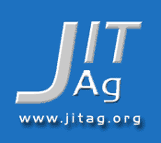Layout Formats
Title
The title should be centered in upper and lower case on the first line of the article.
Author Information
Author's name, title, institution, city, and email address should be separated from the title by a double space. Each of these items should be centered in upper and lower case on a separate line. In the case of multiple authors, each author's information should be separated by a double space. ( JITAg does not include authors' academic degrees.)
Main Headings
First-level (main) headings within the text should be upper and lower case and use the style Heading 1 in Microsoft Word or the equivalent in WordPerfect.
Second-Level Headings
Second-level headings should be upper and lower case and use the style Heading 2. (Third-level headings, if appropriate, should be upper and lower case and use the style Heading 3.)
Text/Paragraphs
Paragraphs should be left justified and separated from each other by a single space. That is, authors should use the text block style and should not indent paragraphs by any means.
References
JITAg does not use footnote or endnotes. A "References" section should follow the body of the article. It should include only those sources cited in the article.
The "References" section and the reference citations in the text should conform to the style of the Publication Manual of the American Psychological Association, Fifth Edition. This is the responsibility of the author.
Citations in the "References" section to online material should include URLs and be formatted according to the Publication Manual of the American Psychological Association, Fifth Edition. This, too, is the responsibility of the author.
Abstract
The abstract should appear at the very end of the article, after the "References" section. The heading "Abstract" (not the title and authors of the article) should be centered and separated from the article by a double space. The abstract text should be left justified and separated from the heading "Abstract" by a single space.
The abstract should describe in 100 words or less: (a) the article topic (in one sentence, if possible); (b) the purpose, thesis, or organizing concept of the article and the scope of the article; (c) the sources of data used, if appropriate; and (d) conclusions, recommendations, and implications.
The abstract appears on the "Contents" page under the article title. Thus, authors should make their abstracts interesting enough to motivate subscribers to read their articles.
Table & Graphic Formats
Tables
Tables should be constructed with the table facility of Microsoft Word and should be inserted at appropriate points in the text. They should be inserted between paragraphs, not within them.
Tables should not be excessively large, particularly horizontally.
Graphics
Graphics may be used in the form of charts/figures or photographs. These graphics should have a material impact on the content of the article and not be used for decorative purposes. No more than 8 graphics may be used with any one article, except at the Editor's discretion.
It is the responsibility of authors to provide Web-ready, computer- generated graphics suitable for publication. Authors should keep the number of colors they use in graphics to a minimum and make sure the colors are distinct. JITAg will not convert graphics to other formats or perform other adjustments such as cropping.
Graphics should not be too large to fit on a typical computer screen without scrolling. Thus, the largest size should be 500x400 pixels.
Graphics should be either embedded within the Microsoft Word document, or included as GIF or JPEG files.
Charts/figures should be either embedded drawings or GIF files. Photographs should be in JPEG format.
No background graphics are acceptable.
Other Format Considerations
Fonts
Authors should use a single default font and font size for body text. They should not change font color.
Lists
Bullet and numbered lists are encouraged.
Hypertext Links
Authors may include HTML hypertext links using URLs. Authors should check the links they include immediately before submission. JITAg is not responsible for checking these links.
Bold, Italics, Underline
Judicious highlighting using bold and italics is acceptable. Underlining is not acceptable.
HTML Forms
HTML forms are not acceptable.
Other Web Enhancements
JITAg does not support other Web enhancements at this time. These include such formats as multimedia (sound/video), applets of all kinds, and Java.
Submission Procedures
Review Procedures
Help for JITAg Authors
Q&A for Authors

